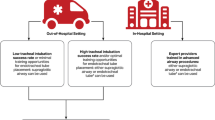Abstract
As the pathophysiology of CPR is understood, ways to alter cerebral blood flow and neurologic outcome following CPR are likely to develop. This review highlights those areas likely to be of clinical importance in the near future.
Similar content being viewed by others
References
Kouwenhoven WB, Jude JR, Knickerbocker GG (1960) Closed-chest massage. JAMA 173:1064
Criley JM, Blarfuss AH, Kissel GL (1976) Cough-induced cardiac compression. JAMA 263:1246
Weisfeldt ML, Chandra N, Tsitlik J (1981) Increased intrathoracic pressure not direct heart compression — causes the rises in intra-thoracic vascular pressures during CPR in dogs and pigs. Crit Care Med 9:377
Rudikoff MT, Maughan WL, Effron M, Freund P, Weisfeldt ML (1980) Mechanism of blood flow during cardiopulmonary resuscitation. Circulation 61:345
Weisfeldt ML (1983) Augmentation of cerebral perfusion by simultaneous chest compression and lung inflation with abdominal binding following cardiac arrest in dogs. Circulation 67:266
Chandra N, Weisfeldt ML, Tsitlik J, Vaglhaiwalla F, Snyder LD, Hoffecker M, Rudikoff MT (1981) Augmentation of carotid flow during CPR by ventilation at high airway pressure simultaneous with chest compression. Am J Cardiol 48:1053
Chandra N, Rudikoff M, Weisfeldt ML (1980) Simultaneous chest compression and ventilation at high airway pressure during cardiopulmonary resuscitation. Lancet I:175
Shapiro HM, Marshall LF (1978) Intracranial pressure responses to PEEP in head-injured patients. J Trauma 18:254
Luce JM, Huseby JS, Kirk W, Butler J (1982) Mechanisms by which positive end expiratory pressure increases cerebrospinal fluid pressure in dogs. J Appl Physiol 52:231
Rogers MC, Nugent SK, Stidham GL (1979) Effects of closed-chest cardiac massage in intracranial pressure. Crit Care Med 7:454
Michael JR, Guerci AD, Koehler RC, et al. (1984) Mechanisms whereby epinephrine augments cerebral and myocardial perfusion during cardiopulmonary resuscitation in dogs. Circulation 69:822
White BC, Gadzinski DS, Hoehner PJ, et al. (1982) Effect of flunarizine on canine cerebral cortical blood flow and vascular resistance post cardiac arrest. Ann Emerg Med 11:119
Hoehner PJ, Krause GS, White BC, Gadzinski DS (1983) Determination of cerebral cortical blood flow: a thermal technique. Ann Emerg Med 12:19
Dean JM, Hoehner PJ, Rogers MC, Traystman RJ (1984) Effect of lidoflazine on cerebral blood flow following 12 minutes of total cerebral ischemia. Stroke 15:531
Newberg LA, Steen PA, Milde JH, Michenfelder JD (1984) Failure of flunarizine to improve cerebral blood flow or neurologic recovery in a canine model of complete cerebral ischemia. Stroke 15:666
Steen PA, Newberg LA, Milde JH, Michenfelder JD. Cerebral blood flow and neurologic outcome when nimodipine is given after complete cerebral ischemia in the dog. J Cereb Blood Flow Metab (in press)
Author information
Authors and Affiliations
Rights and permissions
About this article
Cite this article
Rogers, M.C. The physiology of cardiopulmonary resuscitation. Intensive Care Med 15 (Suppl 1), S5–S8 (1989). https://doi.org/10.1007/BF00260874
Issue Date:
DOI: https://doi.org/10.1007/BF00260874




